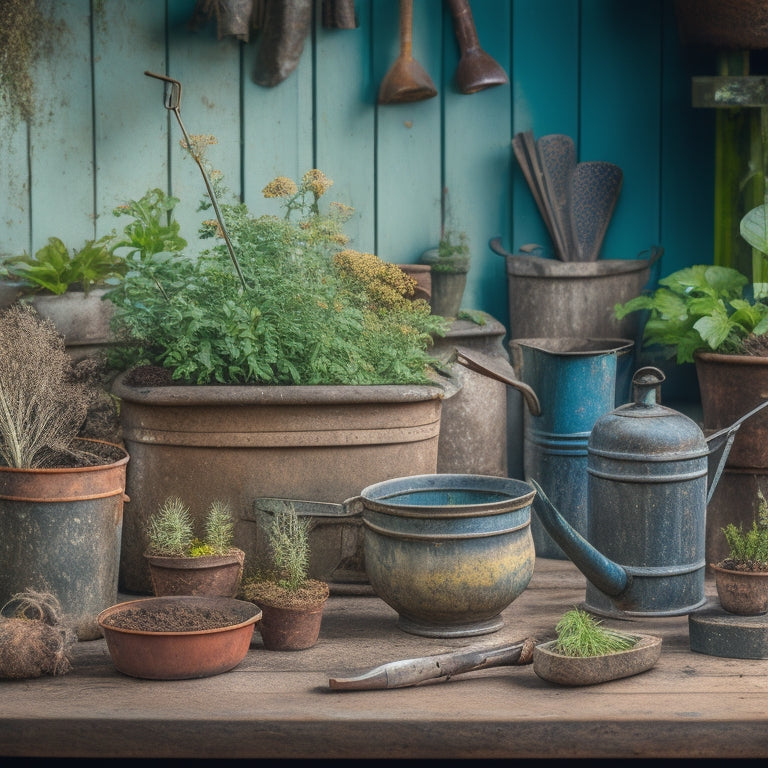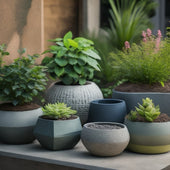
Inspect and Revive Second-Hand Tools for Planters
Share
When inspecting and reviving second-hand tools for planters, prioritize tools with sturdy builds and functional parts, and consider reputable brands like DeWalt or Bosch. Examine surfaces for rust, corrosion, or cracks, and check handles for looseness or breakage. Soak tools in a vinegar-water solution to loosen dirt, scrub with a soft-bristled brush, and disinfect with hydrogen peroxide. Identify damaged components requiring repair or replacement, and consult original manuals for part specifications. By following these steps, you'll be well on your way to transforming discarded tools into functional masterpieces - and there's even more to discover as you dive deeper into the art of tool revival.
Key Takeaways
- Inspect second-hand tools for damage, rust, and wear, and prioritize those with sturdy builds and functional parts for planters.
- Clean and disinfect tools thoroughly to remove dirt and grime, and sharpen or replace worn-out parts for optimal performance.
- Consider unique features like vintage designs or creative materials like colanders or wire baskets to enhance planter aesthetics.
- Organize and store tools safely in designated areas, using storage solutions like toolboxes, bins, and hooks to keep them off the floor.
- Regularly inspect and maintain tools to prevent rust and corrosion, and schedule seasonal upkeep for optimal tool longevity.
Tool Selection and Purchase Tips
When scouring second-hand markets for tools to repurpose as planters, selecting the right pieces is essential. You'll want to prioritize tools with sturdy builds, minimal rust, and functional parts.
Budget considerations play a significant role in your selection process. Set a price range and stick to it to avoid overspending. For high-quality, affordable options, consider brands like DeWalt, Bosch, or Black+Decker.
Brand recommendations aside, look for tools with unique features that can enhance your planter's aesthetic. A vintage metal trough with a decorative handle or an old wooden toolbox with a rustic charm can add character to your garden.
Don't be afraid to think outside the box – or in this case, the toolbox. Consider unusual items like old colanders, wire baskets, or even metal pipes to create one-of-a-kind planters.
Inspecting for Damage and Wear
During your treasure hunt for second-hand tools to repurpose as planters, you'll inevitably encounter pieces that show signs of wear and tear. Inspecting for damage and wear is essential to guarantee the tool's safety and longevity as a planter.
Start by examining the tool's surface for rust, corrosion, or cracks, which can compromise its structural integrity. Check for loose or broken handles, as they can pose a safety risk when handling the planter.
Inspect the tool's metal components for signs of fatigue, such as bending or warping, which can lead to breakage. Take note of any worn-out or damaged moving parts, like hinges or pivot points, that may need replacement.
Additionally, look for signs of previous repairs or modifications that may affect the tool's overall stability. By conducting a thorough inspection, you'll be able to identify potential issues and take necessary safety precautions to revive the tool as a sturdy and functional planter.
This attention to detail will ultimately extend the tool's lifespan and guarantee a successful upcycling project.
Cleaning and Disinfecting Process
With your treasure trove of second-hand tools inspected for damage and wear, you're ready to tackle the essential step of cleaning and disinfecting.
This vital process removes dirt, grime, and potential contaminants that can spread diseases to your plants.
To guarantee a thorough cleaning, follow these steps:
-
Soak tools in a cleaning solution: Mix 1 part white vinegar with 2 parts water in a large bucket. Submerge your tools for at least 30 minutes to loosen dirt and debris.
-
Scrub tools with a soft-bristled brush: Use a gentle touch to remove stubborn dirt and grime, paying attention to crevices and corners.
-
Rinse tools thoroughly: Use clean water to remove any remaining cleaning solution and debris.
- Disinfect tools with a hydrogen peroxide solution: Mix equal parts hydrogen peroxide and water in a spray bottle. Spray the solution onto your tools and let them air dry.
Repairing and Replacing Parts
Now that your second-hand tools are sparkling clean and disinfected, frequently you'll find that some parts may still be worn out or damaged, requiring repair or replacement to guarantee peak performance and longevity.
To guarantee ideal tool functionality, you'll need to identify the damaged components and source compatible replacement parts. This may involve consulting the tool's original manual or manufacturer's website for part numbers and specifications.
Additionally, you can explore online marketplaces or specialty stores for compatible parts, taking care to verify the seller's reputation and product authenticity.
When replacing parts, verify that they're compatible with your tool's make and model to avoid compromising its performance or safety.
Moreover, consider refurbishing or upgrading worn-out components to extend the tool's lifespan and improve its overall efficiency.
Sharpening and Lubricating Tools
You'll need to refurbish the tool's edge to restore its cutting performance, which involves sharpening the blade to its original angle and removing any nicks or burrs.
To prevent rust, apply a lubricant to the tool's metal surfaces, paying special attention to pivot points and moving parts.
Tool Edge Refurbish
As rusty tools emerge from their storage, their dulled edges cry out for refurbishment. You'll need to sharpen and lubricate them to restore their former glory.
Tool edge refurbish is a critical step in reviving second-hand tools for planters.
To achieve ideal results, follow these steps:
-
Inspect the edge: Examine the tool's edge under good lighting to identify nicks, chips, or corrosion. This will help you determine the extent of refurbishment required.
-
Adjust the bevel: Use a sharpening stone or file to adjust the bevel, guaranteeing it's even and consistent. This will improve the tool's cutting performance.
-
Align the edge: Use a jig or guide to guarantee the edge is properly aligned, as misalignment can lead to uneven cutting and further damage.
- Lubricate the tool: Apply a rust-inhibiting lubricant to the tool's edge and moving parts to prevent corrosion and wear.
Rust Prevention Tips
Sharpening and lubricating your tools is only half the battle; preventing rust from forming in the first place is equally important. Rust can spread quickly, rendering your tools useless and even damaging other equipment. To prevent this, you'll need to employ rust prevention techniques.
| Rust Prevention Methods | Description |
|---|---|
| Apply Protective Coatings | Use rust-inhibiting coatings like WD-40, silicone sprays, or wax-based products to shield metal surfaces from moisture. |
| Store Tools Properly | Keep tools in a dry, well-ventilated area, away from direct sunlight and moisture. Use toolboxes or storage containers with desiccant packets to maintain a dry environment. |
| Regularly Clean Tools | Remove dirt, grime, and plant residue using a soft-bristled brush, soap, and water. Dry tools thoroughly before storing them. |
Organizing and Storing Tools Safely
You'll need to take into account various tool storage options, such as cabinets, chests, and pegboards, to keep your planter tools organized and within reach.
To guarantee tool care essentials, like cleaning and maintenance, are met, you'll also want to develop a routine for regular inspections and upkeep.
Tool Storage Options
Your tool collection's value lies not only in its quality but also in how well you maintain and organize it. Proper tool storage solutions are essential to prolong the lifespan of your tools and keep them in good condition.
When it comes to tool storage options, consider the following:
-
Vertical storage: Maximize your storage space by using wall-mounted tool holders, hooks, or pegboards to keep frequently used tools within easy reach.
-
Tool chests and cabinets: Invest in a sturdy, well-organized tool chest or cabinet to store larger or less frequently used tools, keeping them protected from dust and moisture.
-
Portable toolboxes: Use portable toolboxes to store and transport tools to different work areas or job sites, keeping them organized and easily accessible.
- Modular storage systems: Implement modular storage systems, such as stackable bins or drawers, to customize your tool storage according to your specific needs.
Tool Care Essentials
Proper tool storage sets the stage for effective tool care. You'll want to create a system that protects your tools from damage, rust, and corrosion. Start by designating a specific area for tool storage, such as a shed, garage, or designated corner of your workspace.
Organize tools by category, like pruning, digging, and planting, to guarantee easy access and retrieval. Use storage solutions like toolboxes, bins, and hooks to keep tools off the floor and out of the way. Clean and dry tools before storing them to prevent rust and corrosion.
Regularly inspect stored tools for signs of wear or damage, addressing issues promptly to prevent them from becoming major problems. Seasonal upkeep is also essential for tool maintenance. Schedule regular cleaning and maintenance sessions to keep your tools in top condition.
Perform tasks like sharpening, oiling, and replacing worn parts to guarantee your tools remain effective and efficient. By implementing these tool care essentials, you'll extend the lifespan of your second-hand tools and guarantee they continue to serve you well in your planting endeavors.
Labeling and Signage
Clear labels and signage are essential for efficiently storing and retrieving tools, ensuring that your organized system remains functional and safe.
You've invested time and effort into inspecting and reviving your second-hand tools, and now it's vital to maintain that organization.
Label design should be clear, concise, and easy to read. Avoid using abbreviations or jargon that might confuse you or others. Use a consistent font and color scheme throughout your labeling system.
- Label each tool: Identify the tool, its type, and its intended use.
- Label storage compartments: Clearly mark the contents of each storage bin, drawer, or shelf.
- Signpost tool categories: Use signs or placards to categorize tools by type, such as "Pruning Tools" or "Soil Preparation Tools".
- Indicate tool status: Use color-coding or icons to indicate whether a tool is in good condition, needs maintenance, or is ready for disposal.
Proper signage placement is also critical. Place labels and signs in a location that's easy to read, such as on the front of a storage bin or above a shelf.
Frequently Asked Questions
Can I Use Second-Hand Tools With Rust for Planting?
You can't safely use second-hand tools with rust for planting without proper rust removal, as it compromises tool safety, risking damage to your plants and yourself; take the time to restore them correctly to guarantee a successful harvest.
How Do I Know if a Tool Is Worth Reviving?
Carefully calculate the tool's revival cost, considering the condition's complexity, before committing to restore it, as you'll want to guarantee the expense doesn't outweigh the tool's potential performance and lifespan, making it a worthy revival investment.
Are Antique Tools Better for Planters Than Modern Ones?
You're weighing antique tools' durability against modern ones' efficiency for planters. Antique tools often boast superior craftsmanship, but may lack modern materials' lightness and corrosion resistance, while modern tools provide ease of use, but might sacrifice quality for mass production.
Can I Repaint or Refinish Second-Hand Tools?
When refinishing second-hand tools, you'll want to follow precise tool restoration tips, ensuring a durable finish; opt for eco-friendly painting methods, like using natural oils or milk paints, and apply thin coats to maintain the tool's original integrity.
Do Second-Hand Tools Require Special Maintenance Schedules?
When acquiring second-hand tools, you'll want to establish a tailored maintenance schedule, as neglect can lead to premature wear; by applying restoration techniques, you'll reap maintenance benefits, ensuring peak performance and extending the tool's lifespan.
Conclusion
As you hold your revived toolbox, remember that every refurbished tool is like a phoenix rising from the ashes. Once discarded, now they shine, ready to nurture new life in your planters. Like a master gardener, you've coaxed them back to health, and they'll reward you with bountiful harvests. Your hands, now skilled and confident, will cultivate growth, just as you've cultivated new life in these second-hand tools.
Related Posts
-

5 Best DIY Planter Ideas to Upcycle Concrete
You're about to breathe new life into discarded concrete blocks by transforming them into functional and visually app...
-

5 Best DIY Planter Ideas to Upcycle Concrete
You're about to breathe new life into discarded concrete blocks by transforming them into functional and visually app...
-

5 Best DIY Planter Ideas to Upcycle Concrete
You're about to breathe new life into discarded concrete blocks by transforming them into functional and visually app...
-

5 Best DIY Planter Ideas to Upcycle Concrete
You're about to breathe new life into discarded concrete blocks by transforming them into functional and visually app...
-

5 Best DIY Planter Ideas to Upcycle Concrete
You're about to breathe new life into discarded concrete blocks by transforming them into functional and visually app...
-

5 Best DIY Planter Ideas to Upcycle Concrete
You're about to breathe new life into discarded concrete blocks by transforming them into functional and visually app...
-

5 Best DIY Planter Ideas to Upcycle Concrete
You're about to breathe new life into discarded concrete blocks by transforming them into functional and visually app...
-

5 Best DIY Planter Ideas to Upcycle Concrete
You're about to breathe new life into discarded concrete blocks by transforming them into functional and visually app...
-

5 Best DIY Planter Ideas to Upcycle Concrete
You're about to breathe new life into discarded concrete blocks by transforming them into functional and visually app...
-

5 Best DIY Planter Ideas to Upcycle Concrete
You're about to breathe new life into discarded concrete blocks by transforming them into functional and visually app...
-

5 Best DIY Planter Ideas to Upcycle Concrete
You're about to breathe new life into discarded concrete blocks by transforming them into functional and visually app...
-

5 Best DIY Planter Ideas to Upcycle Concrete
You're about to breathe new life into discarded concrete blocks by transforming them into functional and visually app...
-

5 Best DIY Planter Ideas to Upcycle Concrete
You're about to breathe new life into discarded concrete blocks by transforming them into functional and visually app...
-

5 Best DIY Planter Ideas to Upcycle Concrete
You're about to breathe new life into discarded concrete blocks by transforming them into functional and visually app...
-

5 Best DIY Planter Ideas to Upcycle Concrete
You're about to breathe new life into discarded concrete blocks by transforming them into functional and visually app...
-

5 Best DIY Planter Ideas to Upcycle Concrete
You're about to breathe new life into discarded concrete blocks by transforming them into functional and visually app...
-

5 Best DIY Planter Ideas to Upcycle Concrete
You're about to breathe new life into discarded concrete blocks by transforming them into functional and visually app...
-

5 Best DIY Planter Ideas to Upcycle Concrete
You're about to breathe new life into discarded concrete blocks by transforming them into functional and visually app...
-

Selecting the Right Planter Dimensions for Your Space
When selecting the right planter dimensions for your space, you'll want to carefully consider the available area, mea...
-

Selecting the Right Planter Dimensions for Your Space
When selecting the right planter dimensions for your space, you'll want to carefully consider the available area, mea...
-

Selecting the Right Planter Dimensions for Your Space
When selecting the right planter dimensions for your space, you'll want to carefully consider the available area, mea...
-

Selecting the Right Planter Dimensions for Your Space
When selecting the right planter dimensions for your space, you'll want to carefully consider the available area, mea...
-

Selecting the Right Planter Dimensions for Your Space
When selecting the right planter dimensions for your space, you'll want to carefully consider the available area, mea...
-

Selecting the Right Planter Dimensions for Your Space
When selecting the right planter dimensions for your space, you'll want to carefully consider the available area, mea...
-

Selecting the Right Planter Dimensions for Your Space
When selecting the right planter dimensions for your space, you'll want to carefully consider the available area, mea...
-

Selecting the Right Planter Dimensions for Your Space
When selecting the right planter dimensions for your space, you'll want to carefully consider the available area, mea...
-

Selecting the Right Planter Dimensions for Your Space
When selecting the right planter dimensions for your space, you'll want to carefully consider the available area, mea...
-

Selecting the Right Planter Dimensions for Your Space
When selecting the right planter dimensions for your space, you'll want to carefully consider the available area, mea...
-

Selecting the Right Planter Dimensions for Your Space
When selecting the right planter dimensions for your space, you'll want to carefully consider the available area, mea...
-

Selecting the Right Planter Dimensions for Your Space
When selecting the right planter dimensions for your space, you'll want to carefully consider the available area, mea...
-

Selecting the Right Planter Dimensions for Your Space
When selecting the right planter dimensions for your space, you'll want to carefully consider the available area, mea...
-

Selecting the Right Planter Dimensions for Your Space
When selecting the right planter dimensions for your space, you'll want to carefully consider the available area, mea...
-

Selecting the Right Planter Dimensions for Your Space
When selecting the right planter dimensions for your space, you'll want to carefully consider the available area, mea...
-

Selecting the Right Planter Dimensions for Your Space
When selecting the right planter dimensions for your space, you'll want to carefully consider the available area, mea...
-

Selecting the Right Planter Dimensions for Your Space
When selecting the right planter dimensions for your space, you'll want to carefully consider the available area, mea...
-

Selecting the Right Planter Dimensions for Your Space
When selecting the right planter dimensions for your space, you'll want to carefully consider the available area, mea...
-

Selecting the Right Planter Dimensions for Your Space
When selecting the right planter dimensions for your space, you'll want to carefully consider the available area, mea...
-

Selecting the Right Planter Dimensions for Your Space
When selecting the right planter dimensions for your space, you'll want to carefully consider the available area, mea...
-

Selecting the Right Planter Dimensions for Your Space
When selecting the right planter dimensions for your space, you'll want to carefully consider the available area, mea...
-

Selecting the Right Planter Dimensions for Your Space
When selecting the right planter dimensions for your space, you'll want to carefully consider the available area, mea...
-

Selecting the Right Planter Dimensions for Your Space
When selecting the right planter dimensions for your space, you'll want to carefully consider the available area, mea...
-

Selecting the Right Planter Dimensions for Your Space
When selecting the right planter dimensions for your space, you'll want to carefully consider the available area, mea...
-

Selecting the Right Planter Dimensions for Your Space
When selecting the right planter dimensions for your space, you'll want to carefully consider the available area, mea...
-

Selecting the Right Planter Dimensions for Your Space
When selecting the right planter dimensions for your space, you'll want to carefully consider the available area, mea...
-

Selecting the Right Planter Dimensions for Your Space
When selecting the right planter dimensions for your space, you'll want to carefully consider the available area, mea...
-

Selecting the Right Planter Dimensions for Your Space
When selecting the right planter dimensions for your space, you'll want to carefully consider the available area, mea...
-

Selecting the Right Planter Dimensions for Your Space
When selecting the right planter dimensions for your space, you'll want to carefully consider the available area, mea...
-

Selecting the Right Planter Dimensions for Your Space
When selecting the right planter dimensions for your space, you'll want to carefully consider the available area, mea...
-

Selecting the Right Planter Dimensions for Your Space
When selecting the right planter dimensions for your space, you'll want to carefully consider the available area, mea...
-

Selecting the Right Planter Dimensions for Your Space
When selecting the right planter dimensions for your space, you'll want to carefully consider the available area, mea...
-

Selecting the Right Planter Dimensions for Your Space
When selecting the right planter dimensions for your space, you'll want to carefully consider the available area, mea...
-

5 Tips for Thriving Vertical Vegetable Gardens
To thrive in vertical vegetable gardening, you'll want to choose a planter that meets the unique needs of your veggie...
-

5 Tips for Thriving Vertical Vegetable Gardens
To thrive in vertical vegetable gardening, you'll want to choose a planter that meets the unique needs of your veggie...
-

5 Tips for Thriving Vertical Vegetable Gardens
To thrive in vertical vegetable gardening, you'll want to choose a planter that meets the unique needs of your veggie...
-

5 Tips for Thriving Vertical Vegetable Gardens
To thrive in vertical vegetable gardening, you'll want to choose a planter that meets the unique needs of your veggie...
-

5 Tips for Thriving Vertical Vegetable Gardens
To thrive in vertical vegetable gardening, you'll want to choose a planter that meets the unique needs of your veggie...
-

5 Tips for Thriving Vertical Vegetable Gardens
To thrive in vertical vegetable gardening, you'll want to choose a planter that meets the unique needs of your veggie...
-

5 Tips for Thriving Vertical Vegetable Gardens
To thrive in vertical vegetable gardening, you'll want to choose a planter that meets the unique needs of your veggie...
-

5 Tips for Thriving Vertical Vegetable Gardens
To thrive in vertical vegetable gardening, you'll want to choose a planter that meets the unique needs of your veggie...
-

5 Tips for Thriving Vertical Vegetable Gardens
To thrive in vertical vegetable gardening, you'll want to choose a planter that meets the unique needs of your veggie...
-

5 Tips for Thriving Vertical Vegetable Gardens
To thrive in vertical vegetable gardening, you'll want to choose a planter that meets the unique needs of your veggie...
-

5 Tips for Thriving Vertical Vegetable Gardens
To thrive in vertical vegetable gardening, you'll want to choose a planter that meets the unique needs of your veggie...
-

5 Tips for Thriving Vertical Vegetable Gardens
To thrive in vertical vegetable gardening, you'll want to choose a planter that meets the unique needs of your veggie...
-

5 Tips for Thriving Vertical Vegetable Gardens
To thrive in vertical vegetable gardening, you'll want to choose a planter that meets the unique needs of your veggie...
-

5 Tips for Thriving Vertical Vegetable Gardens
To thrive in vertical vegetable gardening, you'll want to choose a planter that meets the unique needs of your veggie...
-

5 Tips for Thriving Vertical Vegetable Gardens
To thrive in vertical vegetable gardening, you'll want to choose a planter that meets the unique needs of your veggie...
-

5 Tips for Thriving Vertical Vegetable Gardens
To thrive in vertical vegetable gardening, you'll want to choose a planter that meets the unique needs of your veggie...
-

5 Tips for Thriving Vertical Vegetable Gardens
To thrive in vertical vegetable gardening, you'll want to choose a planter that meets the unique needs of your veggie...


